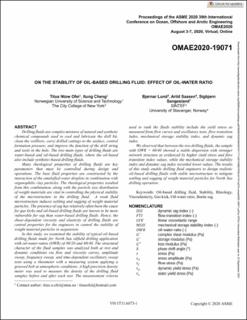| dc.description.abstract | Drilling fluids are complex mixtures of natural and synthetic chemical compounds used to cool and lubricate the drill bit, clean the wellbore, carry drilled cuttings to the surface, control formation pressure, and improve the function of the drill string and tools in the hole. The two main types of drilling fluids are water-based and oil-based drilling fluids, where the oil-based also include synthetic-based drilling fluids.
Many rheological properties of drilling fluids are key parameters that must be controlled during design and operations. The base fluid properties are constructed by the interaction of the emulsified water droplets in combination with organophilic clay particles. The rheological properties resulted from this combination, along with the particle size distribution of weight materials are vital in controlling the physical stability of the microstructure in the drilling fluid. A weak fluid microstructure induces settling and sagging of weight material particles. The presence of sag has relatively often been the cause for gas kicks and oil-based drilling fluids are known to be more vulnerable for sag than water-based drilling fluids. Hence, the shear-dependent viscosity and elasticity of drilling fluids are central properties for the engineers to control the stability of weight material particles in suspension.
In this study, we examined the stability of typical oil-based drilling fluids made for North Sea oilfield drilling application with oil-water-ratios (OWR) of 80/20 and 60/40. The structural character of the fluid samples was analyzed both at rest and dynamic conditions via flow and viscosity curves, amplitude sweep, frequency sweep, and time-dependent oscillatory sweep tests using a rheometer with a measuring system applying a grooved bob at atmospheric conditions. A high precision density meter was used to measure the density of the drilling fluid samples before and after each test. The measurement criteria used to rank the fluids stability include the yield stress as measured from flow curves and oscillatory tests, flow transition index, mechanical storage stability index, and dynamic sag index.
We observed that between the two drilling fluids, the sample with OWR = 60/40 showed a stable dispersion with stronger network structure as evidenced by higher yield stress and flow transition index values, while the mechanical storage stability index and dynamic sag index recorded lower values. The results of this study enable drilling fluid engineers to design realistic oil-based drilling fluids with stable microstructure to mitigate settling and sagging of weight material particles for North Sea drilling operation. | en_US |
